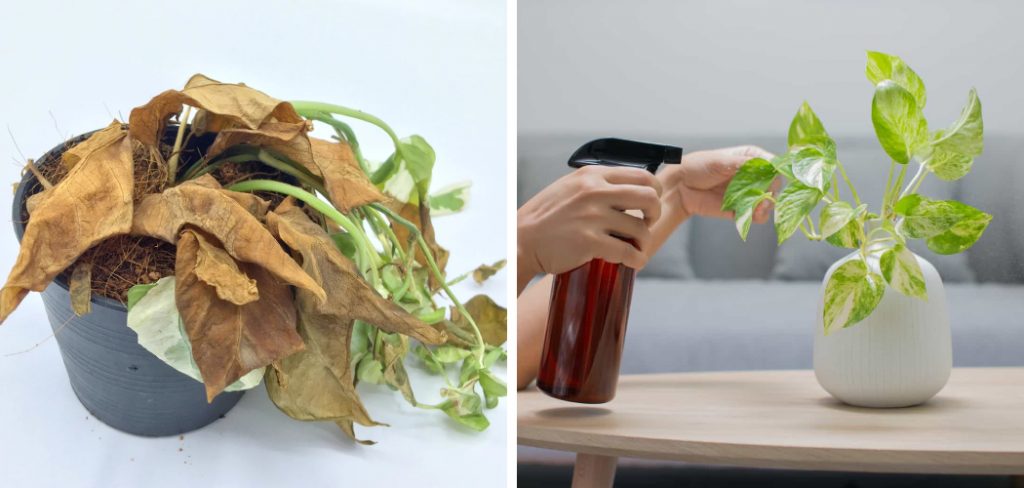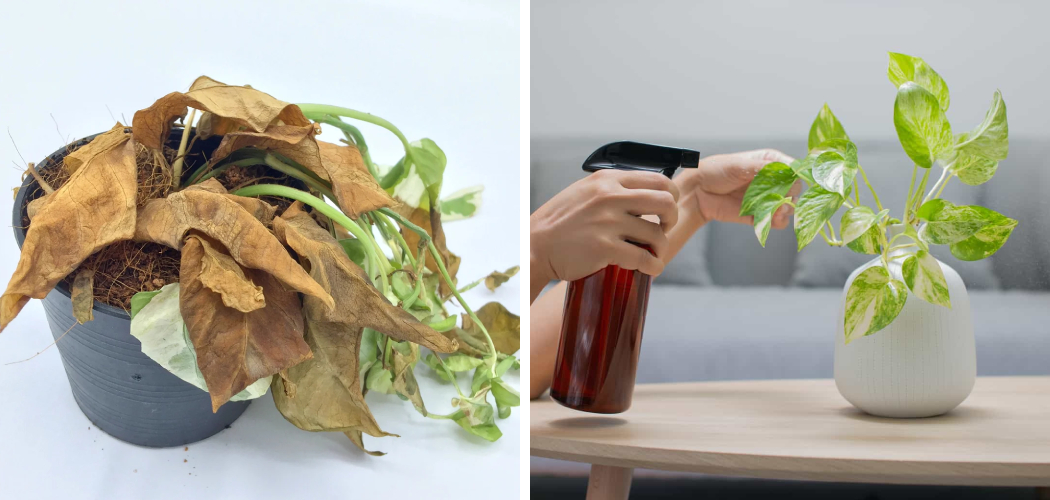To revive pothos, provide it with proper lighting, water it regularly, and fertilize it periodically. Pothos can thrive in indirect sunlight but does best in bright, indirect light conditions.
Water the plant when the top 1-2 inches of the soil feel dry to the touch. Avoid overwatering as it can cause root rot. Use a balanced fertilizer every 4-6 weeks during the growing season to promote healthy growth. Additionally, prune the plant regularly to encourage bushier growth and remove any yellow or wilted leaves.
With proper care, your pothos will flourish and add beauty to your home or office space.

The Basics Of Reviving Pothos Plants
Reviving a struggling Pothos plant requires a keen understanding of its signs. Determine the common challenges faced in growing and maintaining Pothos plants. By recognizing the indicators, you can take appropriate steps to nurture and revive your plant. Be attentive to aspects like wilting leaves and discolored foliage, which could point to issues like over or under watering.
Check for root rot, a common problem caused by excess moisture. If your Pothos plant looks droopy or has stunted growth, inadequate lighting conditions might be the culprit. Adjust the exposure accordingly. Regularly inspect for pests such as spider mites or aphids, as they can harm the plant’s health.
Remember, a strong Pothos plant adds vibrancy to any space, so revive yours using these essential tips.
How to Revive Pothos: Step by Step Guide
Evaluating The Health Of Your Pothos Plant
Evaluating the overall health of your Pothos plant is crucial for its revival. Start by assessing the condition of the leaves and stems. Look for any signs of discoloration, spots, or wilting, as this could indicate underlying issues. It’s equally important to identify potential pest infestations or diseases.
Check the plant closely for any signs of pests or the presence of webs. Additionally, inspect the root system for any signs of rot or damage. Healthy roots should be firm and white, while rotting roots may appear brown or mushy.
By thoroughly evaluating the health of your Pothos plant, you can take appropriate measures to revive it and ensure its continued growth and vitality.
Providing Optimal Lighting And Temperature Conditions
Reviving your Pothos plant starts with providing optimal lighting and temperature conditions. Finding the right balance of natural and artificial light is crucial. Maintain ideal temperature and humidity levels to ensure its well-being. Natural light is essential, so place your Pothos near a window with indirect sunlight.
If natural light is limited, supplement with artificial light using fluorescent or LED bulbs. Avoid exposing the plant to direct sunlight, as it can scorch the leaves. Additionally, ensure the room temperature remains between 60 to 85°F (15-29°C) for Pothos to thrive.
Avoid extreme temperature fluctuations and drafts. Maintain humidity levels by misting the leaves regularly or placing the pot on a tray filled with water and pebbles. Remember, consistent environmental conditions will help your Pothos flourish and regain its vitality. Keep these factors in mind and enjoy a healthy and revived Pothos in your home or office space.
Implementing Correct Watering And Fertilization Techniques
To revive pothos successfully, it is crucial to implement correct watering and fertilization techniques. Determining the appropriate frequency and amount of watering is key. Overwatering can drown the roots, while underwatering can lead to dryness and wilting. It is essential to strike a balance.
Similarly, choosing the right type of fertilizer and applying it properly is vital. Pothos plants thrive with a balanced fertilizer, which contains equal amounts of nitrogen, phosphorus, and potassium. Applying the fertilizer in the correct amount and at the right time will help the plant flourish.
By following these guidelines, pothos can be revived and rejuvenated, creating a beautiful green addition to any indoor space.
Pruning And Trimming For A Healthy Pothos Plant
Pothos plants can easily be revived through regular pruning and trimming. Start by removing any dead or yellowing leaves and stems to promote healthy growth. This helps the plant direct its energy towards new, vibrant foliage. Additionally, shaping the plant can result in a more compact and aesthetically pleasing appearance.
Consider cutting back longer vines or stems to encourage bushier growth. By following these simple steps, you can revive your Pothos and create a thriving indoor plant that adds beauty to your space. Keep in mind that regular maintenance, like watering and providing adequate light, also plays a crucial role in keeping your Pothos healthy and thriving.
Enjoy the process of caring for your Pothos and watch it flourish!
Repotting And Soil Selection Tips
Reviving your Pothos plant involves repotting and selecting the right soil. It’s important to recognize when it’s time to repot your plant. Check for roots growing out of the drainage holes or if the soil dries out quickly. When repotting, choose a container that has enough room for the roots to grow.
Opt for a well-draining soil mix that retains some moisture but doesn’t become waterlogged. A good option is a combination of peat moss, perlite, and potting soil. Before repotting, gently loosen the roots to promote new growth. Once repotted, water your Pothos thoroughly and place it in an area with indirect sunlight.
Remember to keep an eye on its growth and repot as needed to ensure the continued health of your Pothos plant.
Preventing Common Pests And Diseases
Pothos plants can be revived by preventing and managing common pests and diseases. By identifying and controlling pests like aphids and spider mites, the health of the plant can be preserved. Regularly inspect the leaves for any signs of infestation, such as yellowing or distorted growth.
Using a gentle soap and water solution can help remove these pests. Additionally, diseases like root rot can be prevented by ensuring proper drainage and not over-watering the plant. If the plant does develop diseases, it is important to promptly take action by treating it with appropriate remedies or pruning affected parts.
By staying vigilant and taking preventative measures, you can keep your Pothos plants thriving and beautiful.
Troubleshooting Common Problems And Solutions
Reviving Pothos plants can be a breeze if you tackle common issues head-on. One frequent problem is root rot, caused by overwatering. To fix this, assess the plant’s root system and trim away any damaged or rotten roots. Next, allow the soil to dry out between waterings and adjust your watering schedule accordingly.
Another concern is nutrient deficiencies, often evident in yellowing leaves. A simple solution is to provide the plant with a balanced fertilizer, following the recommended dosage. Regularly check for signs of pests or diseases, as these can also cause leaf discoloration.
By addressing these common problems promptly, you can revive your Pothos and enjoy its lush green foliage once again.
Enhancing Growth And Overall Health Of Pothos Plants
To enhance the growth and overall health of your pothos plants, you can provide support structures for climbing varieties. Additionally, methods like propagation and air layering can help to revive pothos. These techniques aid in the growth and propagation of healthy root systems, leading to stronger and more robust plants.
By providing support structures such as trellises or stakes, climbing pothos plants can thrive and grow in a controlled and structured manner. Propagation allows you to create new plants from healthy cuttings, ensuring the continued growth and vitality of your pothos collection.
Air layering, on the other hand, promotes the development of new roots, enabling the plant to absorb more nutrients and water. These methods, along with proper watering, lighting, and soil conditions, will help revive your pothos plants and promote their overall well-being.
Frequently Asked Questions On How To Revive Pothos
How Often Should I Water My Pothos Plant?
Pothos plants prefer slightly dry conditions, so water your Pothos only when the top inch of soil feels dry. Overwatering can lead to root rot, while underwatering can cause the leaves to wilt. Remember, it’s better to underwater than overwater your Pothos.
How Do I Revive A Dying Pothos Plant?
Reviving a dying Pothos starts with assessing the cause of the issue. Check for pests, adjust watering habits, and ensure proper light conditions. Trim yellow or brown leaves, repot if necessary, and consider using a diluted balanced fertilizer to help restore the plant’s health.
How Much Light Does A Pothos Plant Need?
Pothos plants are adaptable to low-light conditions but thrive in bright, indirect light. Place your Pothos near a window, ensuring it receives bright, filtered light for at least a few hours a day. Avoid direct sunlight, as it can scorch the leaves.
Conclusion
To bring your pothos plant back to life, follow the tips and tricks mentioned in this blog post. Remember to provide the right amount of sunlight, water, and nutrient-rich soil. Regularly check for pests and diseases, and take immediate action if any are found.
Pruning is essential for maintaining the shape and health of your pothos, so don’t forget to trim any yellow or damaged leaves. Additionally, always keep an eye on the temperature and humidity levels in your home, as these factors can greatly affect the well-being of your plant.
By following these steps, you can successfully revive your pothos and enjoy its lush green foliage once again. So get started and watch your pothos thrive!

